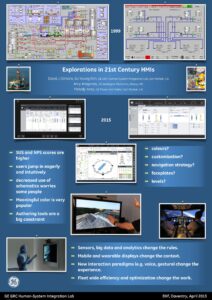The High Performance HMI Handbook (HP-HMI) has galvanized much of industry to look anew at their HMI systems and at GE we have been working to redesign our HMI screens to modern high-performance recommendations and reviewing our designs with users and operators at various plants around the world (now approaching 100 users at about 20 plants in 7 countries), as well as talking to system integrators and others who design and build HMIs (around 30 people across 3-4 countries). A number of important and interesting findings have come to light …
We began this work in broad agreement with the principles of HP-HMI, but we were pleasantly surprised to find that our users’ reactions, SUS scores and NPS scores, etc were all in broad agreement that the new designs were a great step forward. Applying user-centered design methods to HMI is particularly challenging. HP-HMI does not provide all of the answers and still leaves many aspects of the HMI unspecified and it is hard to engage with sufficient users to feel confident about resolving these aspects – the (very great) danger is that users pull you away from 21st century HMI and back towards what they are already familiar with.
The tools for building control systems (and HMIs especially) are a significant bottleneck to improvements. Today there are many ‘shadow’ tools involved (e.g. a spreadsheet or two) and much important information is hidden. Furthermore there is little or no semantics in the system, which makes upgrades and changes extremely challenging to undertake. In particular this creates very real problems for a user-centered iterative approach to design. The HMI is seen by operators as a direct representation of the physical plant, and they see it as critical that it is easy to relate a bit of the HMI to a tangible element of physical plant. This is particularly important in training new operators. Yet, new high performance HMI screens downplay the familiar P&ID diagram and we have found significant resistance to change (often at a management, more than at a user level) color schemes and customization. While it is generally agreed that color is poorly used today (e.g. we visited one plant where green was ‘off’, red was ‘on’ or ‘hot’ and blue was ‘cold’) we have found some resistance to the neutrality of the high-performance HMI and especially to the avoidance of red and green. More generally, we see that many customers want their HMIs across all their plants and systems to be more consistent (to facilitate employee mobility) and yet colors and color schemes vary widely. Thus, we clearly see a need for customization and yet we want to remain true to the principles of HP-HMI.
These issues come to light as we try to design a contemporary HMI, but as we look forward into the next 10 years, there are some trends that are only going to exacerbate them Sensors, big data and analytics (the industrial internet) Mobile and wearable displays New interaction paradigms becoming mainstream (voice, gesture, for example) Pressure for fleet wide controls to deliver efficiency and optimization. Hence we find our project, which began as simply deploying modern HMIs across GE is only just beginning and that we can only call what we have done so far ‘an exploration.’ To bring HMIs truly up to date presents technical, design and human factors challenges that will keep us all busy for many years.
